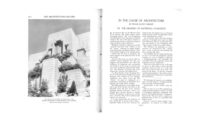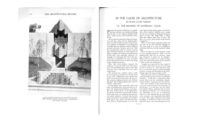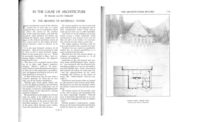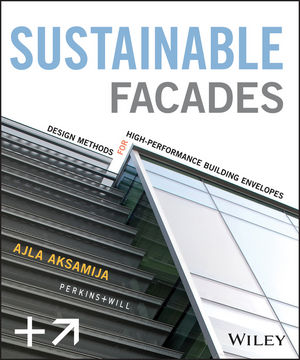Architecture, the Expression of the Materials and Methods of Our Times
LeCorbusier on Architecture








From Architectural Record, August 1929
By "impressive outward show," it is implied that the architecture of today appears to be dictated in the eloquence of its form by modern materials and methods. "Essential truth" suggests an architecture that results from the state of mind of an epoch and that an architecture exists, takes form and is expressed only at that very moment when a general evolution of mind is accomplished.
It is at that moment alone when mind has recognized and admitted a system of thought which, above all, represents in every field a profound modification of previous states. There is no architecture during periods of crisis; architecture comes after periods of crisis.
The crisis then has passed? From the consideration of the world about us the opposite seems certain. Perhaps not; a few spirits (not all–far from that, but only those of leaders–-and that is enough) have passed through the crisis, and have formulated a new attitude of mind which follows completed changes. Only objects–material reality–are in a state of complete disturbance. And why are they? Because precisely at this moment, there breathes a new spirit and the entire world–both man and materials–must inevitably follow the implacable destiny of a new tendency.
Is there then indeed an origin to this profound upheaval? Most certainly. It has existed for a hundred years. During the century our brains have escaped from ancient customs. Our life has gone from day to day, changed bit by bit. And thus we scarcely appreciate it. We were unable to know where all this was leading, we could feel only that it was leading, powerfully, violently, and ever and ever more rapidly.
Meanwhile, shallow spirits of limited vision cried out: "The world is being wrecked, all is lost." And in desperation, like shipwrecked sailors grasping at floating debris, we clung to the past. Never before had so much archaeology been done as during those heroic times when science was pushing us, each day more insistently, along the adventurous paths that lead towards the unknown.
Is not architecture determined by new materials and new methods? (It is high time I were defining what architecture is.) Indeed to all in America belong the new materials, with you modern methods are in use. But for a hundred years your architecture has not evolved. Alone your programs have changed. And you construct your skyscrapers in the manner of students of the Ecole des Beaux-Arts building a private house. I repeat: a hundred years of new materials and new methods have made no change whatsoever in your architectural viewpoint.
It is time, though, to define architecture. Architecture is not building. Architecture is that cast of synthetical thought in response to which the multiple elements of architecture are led synchronically to express a purpose. And as this synthetical purpose is absolutely disinterested, having for object neither to make durable, nor to build rapidly, nor to keep warm, nor to promote sanitation, nor to standardize the domestic usefulness of the house, I would say, since it is above any utilitarian objective, it is an elevated purpose. Its object is to bring us benefits of a different nature from those of material usefulness; its aim is to transport us to an inspired state and thus to bring us enjoyment.
Saying this I find myself in accord with the humblest accomplishment of the simplest conscientious laborer, and on the other hand I put myself in agreement with all the great traditions of the past.
Nevertheless, there exists in these days, an absorption in definitely practical ideas which is precisely expressed by the subject which was suggested to me, "Architecture, the expression of the materials and methods of our times."
I will even say that it is the clue to the present situation. And here is the reason:
A system of thought is imbued with life only when there exists a balance between the results of evolution and the spiritual direction of its progress.
What, then, is the direction of its progress today?
A hundred years of a mechanical era have brought forth an entirely new spectacle. Geometry is supreme. Precision is everywhere. The right angle prevails. There no longer exists any object that does not tend to severity.
Industrialism has stated the postulate of economy: to attain the maximum of result at the minimum of expense.
Science, mathematics, analysis and hypothesis, have all created an authentic machinery of thought. An imperative need of clarity, the search for the solution. It is for that which the mathematicians term the "elegant solution."
Has not this all pervading precision, exactness and accuracy definitely annihilated the imperceptible, distance and mystery? Miraculously, quite the contrary is the case. This century has officially opened to us gates yawning on the infinite, on majesty, silence and mystery. More than ever before, man’s soul is pathetically brought face to face with itself. Never was there an epoch so powerfully, so unanimously inspired. Poetry is everywhere, constant, immanent.
Here, then, is set forth that point of view which constitutes the present era, a veritable magnetic pole towards which swings the compass of our initiatives, of all our initiatives.
Let us come to the point. What, in view of the purity and supreme clarity of this new state of thought, are our present architectural forms? Do we concern ourselves with this gleaming liberty of disinterestedness, of courage and poetry? Alas, how timid we are, how firmly we are chained, like slaves. The past has ensnared us, whereas its law is to cry to us, "carry on–why don’t you progress and move forward?" We are cowardly and timorous, lazy and without imagination.
Cowardly, timorous, lazy and without imagination, because, now and invariably, we want our new houses to resemble the old. What a poverty of creative ability!
Meanwhile the means are at hand; science, mathematics, industry, organization.
We still permit our houses to lie close to a damp and unhealthy ground. We are still discussing whether or not our houses are to have roofs, while roof gardens bring health, joy, and an upheaval of plan replete with magnificent liberties. We are still building our houses of stone, with massive walls, while light and slender cars are speeding at sixty miles an hour through snows or under the tropical sun. We are still employing masons and carpenters on the job, to work in rain or snow, or fair weather, while factories could turn out to perfection that which we accept poorly executed.
And so forth and so on.
Here, now, are my conclusions. In what way are we to allow so many innovations? How are we to select these forms still unknown in the building of houses? How are we to arrange them in such a manner as will bring us anew before an architectural phenomenon as will make us feel once more the vigorous delights of architecture?
A state of new enthusiasm exists; a system of thought has been wrought by a hundred years of investigation and acquired results. We have a line of conduct. Instinctively our choice tends towards such constructive systems, towards such materials as possess forces capable of feeding our enthusiasm. In us moderns the new feelings, an instinct, control actions which are in harmony with each other.
The harmony of former centuries is in confusion. The effect continues but the cause has been swept aside by the mechanical revolution. The mechanical revolution is a new cause–immense phenomenon in the history of mankind. Where are the new effects?
Let us be led by this enthusiasm which animates us. Industrialization, standardization, mass production, all are magnificent implements; let us use these implements.
I wish to give you the basis of my reasoning: I am certain that that which at this moment appears most revolutionary in contemporary architectural creations, be it in France, Germany, Russia, or elsewhere,–all that is still nothing more than the old aspect caught in the quicksands of the past. It is my opinion that as yet we have seen nothing new, done nothing new.
That which will come in architecture will survive only when an urbanism, brought face to face with the present social upheaval, will have created cities of which we have as yet not even an idea, of which we have not yet even considered the possibility.
Such is the progress on the one hand (and it is gigantic by comparison with the means at the disposal of the builders of the Romanesque period, or that of Louis XIV) and on the other hand the architects of the contemporary epoch daring at last to state a problem, and to announce the answer, and thus to give to the world an architectural system which is the resultant of the spirit of an era.
The line of action exists–the modern system of thinking.
The Americans, however, are the people who, having done most for progress, remain for the most part timidly chained to dead traditions.
On the other hand, their willingness to progress further strikes me as boundless. And that is a force which, soon, will swing the balance.










